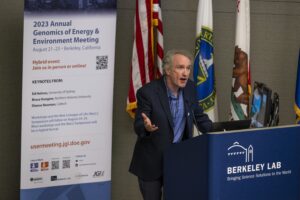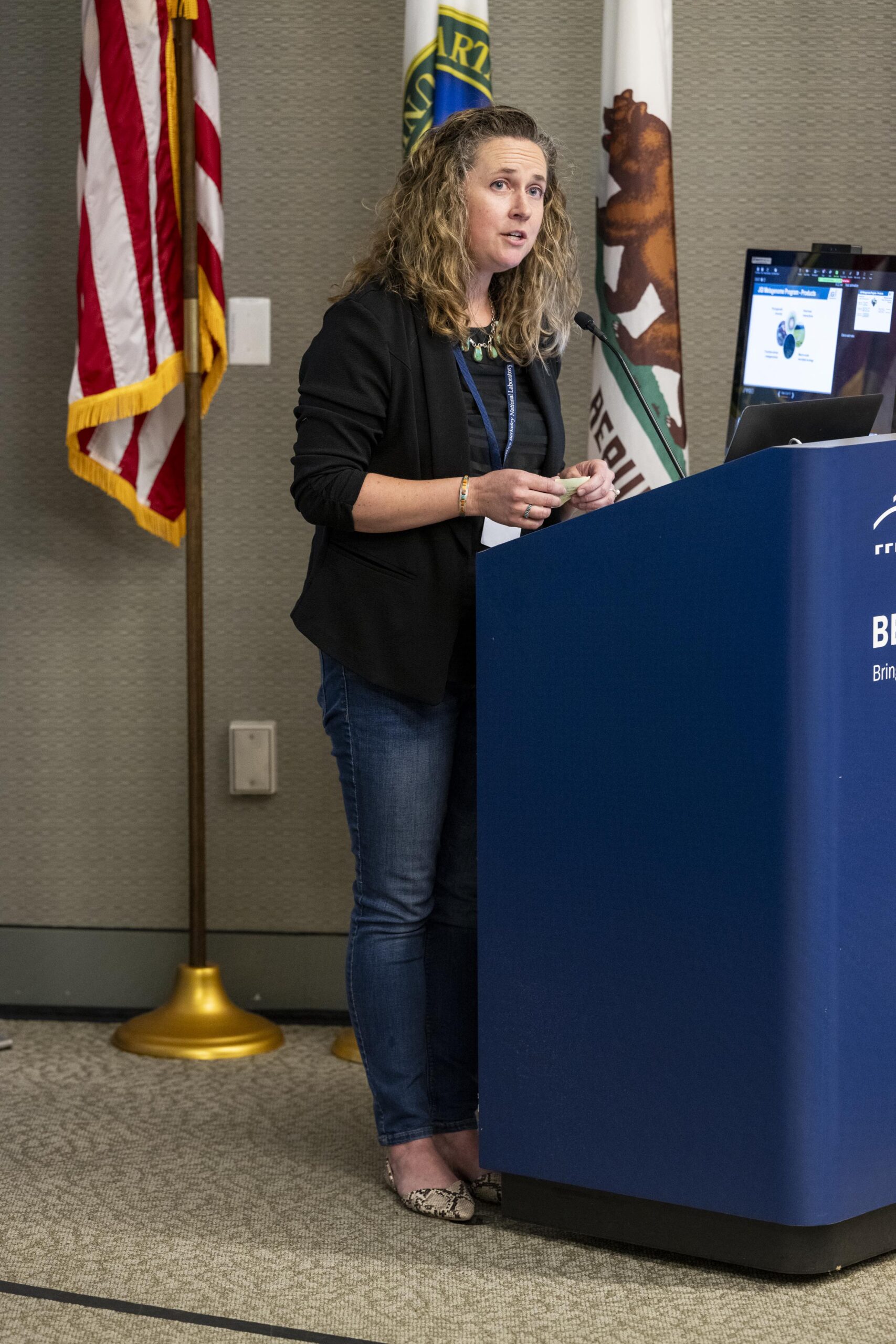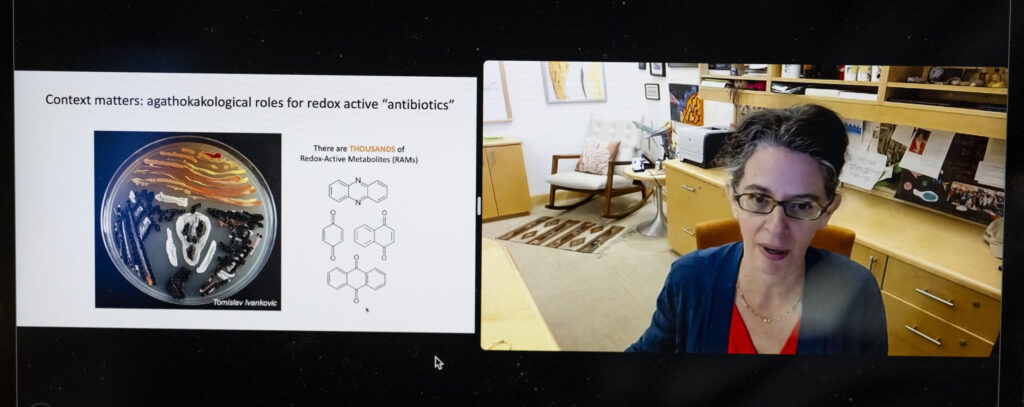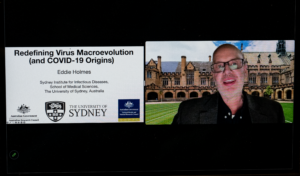From August 21-23, 2023, attendees joined the JGI Annual Genomics of Energy & Environment Meeting. A wide array of invited speakers shared how research infrastructure – DNA sequencing, synthesis, metabolomics, data analysis, and new technology developments – has advanced their work on the world’s most pressing energy and environment challenges.
The JGI offers these solutions to the worldwide scientific community through its User Programs on a competitive, peer-reviewed basis.
Speakers and attendees from many corners of the globe joined this hybrid event, either in person at Lawrence Berkeley National Laboratory (Berkeley Lab), or from afar, online.
Each day, a keynote speaker addressed the conference, sharing the journeys of their research careers, and showcasing the broad applications of their genomics and multi-omics work.
Recordings and recaps of all three keynote talks follow, starting with Bruce Hungate. Jump to Dianne Newman’s talk here, or jump to Edward Holmes’s talk here. Other videos of talks from the JGI Meeting are available here.
Bruce Hungate, Northern Arizona University
Interrogating the microscopic communities at work around the globe
Keynote Talk Title: “Wild Microbial Ecology”

Bruce Hungate shared both enthusiasm and insight in his keynote speech. (Paul Mueller for Berkeley Lab)
Microbial ecologist Bruce Hungate, of Northern Arizona University, delivered the first keynote address of the 2023 JGI Annual Meeting.
As the JGI’s Metagenome Science Program Head, Emiley Eloe-Fadrosh, introduced Bruce Hungate, she explained that when she’d heard Hungate speak years ago, he’d described how microbial communities interact “almost like poetry.”
True to the introduction, Hungate spoke with real enthusiasm, even delight. He qualified his talk title as he took the stage, saying, “to me, the wild adjective there is redundant, because ecology is wild,” and admitting, “friends give me a hard time for that.”
But the title brought him back to his first experiences of microbial ecology, he said, as a student at the University of Washington. In his first cultivation experiments, he said, he realized the value of working across field sampling and lab cultivation.

Emiley Eloe-Fadrosh introduced Bruce Hungate at the 2023 JGI Annual Meeting. (Paul Mueller for Berkeley Lab)
“We need those lab studies to really understand what the organisms can do. And we need the field’s context to see why it matters.”
As his career progressed, Hungate has gotten more interested in microbes with the potential to impact global climate change, he said. “To understand the trajectory of climate change, we need to understand the ecology of those microbes.”
And to understand those microbes, he is most interested in looking through a quantitative lens. This led to the development of a technique called quantitative Stable Isotope Probing, or qSIP — watch his collaborator Jane Marks explain the tool with candy here.
With the development of qSIP, Hungate explained, he and collaborators have been able to explore all kinds of new questions.
“How fast do these organisms grow and die in the wild? How much do they compete? How do microbial traits affect what they do in the wild? And really, my favorite is: how can we attribute element flow — quantitative rates of element flow — to individual species?”
As Hungate shared his approach to those questions during his productive — and ongoing — scientific career, he shared his excitement about tackling a number of challenges. Working with students and colleagues had brought him to new techniques, new understanding of organisms, and new views of how nutrients cycle through ecosystems. Of course, some of those collaborators, like Jennifer Pett-Ridge, were in the room with him as he spoke.
“And what’s happened here at the JGI is really exciting. It’s just a collection of some of the folks, who’ve been pushing forward these techniques and, and making all kinds of super interesting contributions.”
Learn more about Bruce Hungate’s work here.
Dianne Newman, Caltech
“What are the conditions for making metabolites we’re interested in?”
Keynote Talk Title: A Fascination With Phenazines
Dianne Newman is a Gordon M. Binder/Amgen Professor of Biology and Geobiology and the Executive Officer for Biology and Biological Engineering for the Newman lab at Caltech. In her keynote presentation, she began with a contextual framework around what conditions are necessary for making secondary metabolites, noting that “this makes forming hypotheses and the way we go about future biological research much clearer.”
Newman asked the audience if she was showing; “The Scream, or a picture of delight?” She went on to explain that the ambiguity was exactly her point. “Things have one or another function that completely depends on the context and oftentimes a single molecule can be what I like to call ‘agathokakological,’ which is a fancy word for saying ‘composed of both good and evil.’” She added that this term is good to keep in mind when dealing with metabolites that are redox-active — such a phenazines — and while she only showed four out of the millions that exist, they’re now easily identifiable with programs that the JGI has put together.
In collaboration on a project with the Newman lab, an important question arose: who is capable of making phenazines in the environment? Newman explained that, “we were able to develop an algorithm to quantitatively determine what fraction can make phenazines, and which microbes are most capable of generating phenazine production.” This led to them discovering that phenazine producers are enriched in the rhizosphere but also abundant everywhere in the earth’s soils. While she admits that it “0.25% doesn’t seem like a lot (referring to the abundance of phenazine producers in the soil), it’s actually quite significant knowing that there’s one billion bacteria in a teaspoon of soil.” She added that overall, we’re “easily talking about a million of these organisms that are capable of producing phenazines in most environments.”
Knowing that context matters (especially for phenazines), Newman then asked, “can we do anything with this knowledge that’s actually useful? Yes.” She brought the talk back to where she started to underline her point; “If we really want to seek what their functions are in a natural context, we need to understand the rest of the system (both out in the field and in the lab),” Furthermore, she added that phenazines are “keystone metabolites,” and by understanding what these metabolites do in nature and what roles they play, we’ll see much more clearly what the functions they serve are.”
“The main message of this talk,” she concluded, “is that as we leverage these amazing technologies that the JGI has to identify and sequence who’s making what, that the context at a microscale is really what counts in determining our ability to understand and then predict and control what these metabolites do.”
Learn more about Dianne Newman’s work here.
Edward Holmes, University of Sydney
Using protein structures to assess scope of the virosphere
Keynote Talk Title: “Redefining Virus Macroevolution”
Edward Holmes is an evolutionary virologist at the University of Sydney who has been at the forefront of Covid-19 research (see his 2021 VEGA talk). A global authority on viruses, Holmes was part of the initial release the genome sequence for SARS-CoV-2, back in January of 2020. His work has also yielded insights into the origin and spread of viruses like dengue, Ebola, hepatitis C, HIV, influenza, West Nile and Zika.
During his keynote speech at the 2023 JGI Annual Meeting, Holmes discussed how to use genomics and metagenomics to better understand what is called the “virus field,” or the totality of viruses in the universe.
He pointed to significant gaps in our understanding — of what viruses are out there, what they are doing and how they are evolving — and explained how his group uses metatranscriptomics and shotgun RNA sequencing to try to fill those gaps.
Holmes said he is particularly interested in understanding mammalian viruses that may or may not have human origins, and so works with samples from areas where humans and wildlife interact. He described these areas as “fault lines” where viruses can jump from one species to another.
“Under our feet, evolution is happening,” Holmes explained. “There’s a species of germ that’s going on, and occasionally it’s going on to a human — and very occasionally, that might cause an epidemic or a pandemic.”
So Holmes and his group want to better understand how wide this biodiversity is, and what factors determine how a particular virus evolves within a particular ecosystem. There is a wide range of diversity even within a virus group. For example, levels of amino acid are shown to be wildly divergent among sample sites.
“Many of these sequences are no more similar than random,” Holmes said.
Given the vast unknowns contained in metagenomic data sets, Holmes and his group set out to use protein structures to figure out if there were even more divergent viruses that had gone undetected by current scientific research.
“The question is, are there viruses out here you can’t see because they’re too divergent — but they’re there and you can use protein sequences to try and find them,” he explained. “…You train on as many structures as you can, and then you use that trained dataset to interrogate the new data, to try and find those structures in divergent sequences.”
Learn more about Edward Holmes’ work here.

